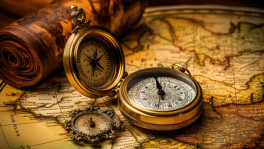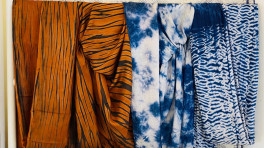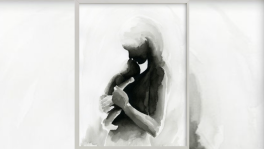Delhi: Time travel to the Mughal era
A city rich in culture, history, architecture, food and many more, Delhi has numerous ancient relics and architecture

Delhi is a city like no other. It has seen more dynasties, emperors and foreign rulers than most historical cities of the world.
It is a city of wonder where you can always find something new to be amazed of.
For visitors, it is always difficult to choose among the many attractions of Delhi, especially when it comes to the field of history, architecture, food, culture and modern, happening things.
During the Covid-19 lockdown, the Indian capital was closed for many weeks and now it is slowly opening up.
I have been visiting Delhi for the last 20 years and always found the best way to start exploring it is by visiting the 'Maqbara-i-Humayun' or the Mughal emperor Humayun's tomb.
It opens early in the morning, so you can avoid crowds and explore one of the greatest architectures of the Mughal era.
It was commissioned and built with the money and design of Humayun's first wife Bega Begum and was inaugurated in 1558.
Some call it the first fusion of Persian and Mughal architecture. In fact, this giant wonder made of red sandstone is often thought as the inspiration behind building the Taj Mahal.
What I like most about this place is that in the morning, you can feel the atmosphere that was a hundred years ago. Moreover, the gardens are great and you can also see many species of birds here.
At its entrance, there is another tomb that is 20 years older and belongs to Mohammed Isa Khan who was an Afghan noble.
The next attraction in Delhi is none other than the Qutub Minar and the mysterious iron pillar next to it.
This 238 feet tall almost 1000 years old minar has been the witness of moving time in this evergreen city.
There are a few other attractions. including the grave and fantastically carved stone pillars.

The iron pillar was once believed to be an Ashoka Pillar, which is almost 2000 years old. It has remained intact and shows the master work of the ancient Indian metalsmiths.
The Qutub Minar itself is a wonder and can make you speechless with its beautiful and perfect architecture and design.

Delhi has been very famous for its food such as Mughal delicacies. And for that one must visit the restaurants in Old Delhi, especially those near the Jama Mosque.
The Jama Mosque was built by the emperor Shah Jahan and inaugurated in 1656.
It is an iconic architecture with giant white domes, tall red minarets and big, open spaces in between them. It is open for all visitors.

I also visited the Lodhi Garden, which was a royal garden for the Lodhi Dynasty and also the resting place of a few of the Sultans.
The place is usually full of morning walkers and yoga lovers, which is a nice sight. But I was really overwhelmed to see wild peacocks and grey Hornbills.
Here you would find the tomb of Sikandar Lodi, the father of Ibrahim Lodi who was defeated by Babur at Panipat.
A stone's throw away from Lodhi Garden is the Lodhi Art District. It is the first open air art gallery and museum in India.
In every corner of every road, you will find house walls painted with spectacular designs with great messages and a lot of them mention nature conservation.
The next thing to see in the Lodhi area is the tomb of Nawab Safdar Jung; a must visit place.
Delhi has so many attractions that you can never see them all even if you stay here for months.

To me, the most mysterious and valuable monument I visited was the Old Fort. Inside it is a lovely octagonal building named 'Sher Mandal' which was used by Humayun as his library. Legend says he fell from the stairs here and died.
But the most important part of the Old Fort is that it contains many 2,500 years old artefacts and relics.

Another grand attraction of Delhi is the Red Fort which was built by emperor Shah Jahan. Inside it are four museums along with the Diwan-i-Am and the Diwan-e-Khas halls.
If you visit Delhi, do not leave before visiting the famous Chandni Chowk. It is a shoppers' paradise and even if you go window shopping, this is a good place to explore.
Delhi has several city forests which are thriving with wildlife. Sanjay Van is one of the most famous of them and very popular among bird lovers. The Daryaganj area is very famous for books.
Transport

Nowadays, it is quite easy and cheap to travel all over Delhi by metro.
All you need to do is just install the app on your phone or check the map and in no time you can reach your destination without getting stuck in traffic.
Uber and Ola are also helpful and you can even rent tuk-tuks (local three-wheelers) through them.
Remember that tourist spots and markets are most crowded on Sundays.
Food

When you exit it from gate one of Jama Mosque, that is when the magic of Old Delhi food begins.
The road outside is usually flooded by hundreds of pedestrians. There are restaurants scattered everywhere and all of them have delicious looking kababs and sweetmeats on display.
The ambience is reminiscent of our beloved Old Dhaka.
The Karim's is probably the most famous restaurant in India which started its journey 110 years ago.
It is said that their ancestor was a chef who worked for Mughal emperor Bahadur Shah Zafar and they still carry the legacy and the recipe.
I would not recommend the biryani here, but all the other items are delicious, especially the mutton burra kabab.
The best time to explore this area is in the evening because after sunset, it wakes up in its full spirit and the shops bustle with customers.
Where to stay
Most of the budget hotels in Delhi are in Paharganj and the room rate starts from as low as Tk1,000 per day. Le Roi, Hotel Aman Continental, The Gold Regency and Hotel York Legacy are some of the best budget hotels. For those who want to stay in luxurious places, there are hotels like Radisson Blu, Leela Palace and Aerocity.
PHOTOS: ASHRAF UDDIN AHMED


 Keep updated, follow The Business Standard's Google news channel
Keep updated, follow The Business Standard's Google news channel
















